Personalization to the rescue
Instead of looking at bandwidth limits as roadblocks, they should be seen by carriers as opportunities. Another strategy that could solve and monetize the video dilemma is personalized or a la carte video packages. These lie in the policy and billing layer, and allow a user to select services or bundles that reflect their preferences with greater specificity. Cable companies are already offering this, but on a limited level (gameday packages, premium channels) and they don't offer true a la carte programming. Consumers who are big sports fans, for instance, but who could care less about the other 75 channels on basic cable, might be inclined to purchase just the live game package if it were an option.
For the internet service provider who doesn't have a play in programming (unlike Comcast), but who does want to control bandwidth, customized "per service" packages should be developed, in which customers pay for exactly what they want. They could even reflect historical patterns back to the user to increase personalization. Imagine a scenario in which a customer could see, from their online account manager, that they watch about 10 movies on Netflix per month, and could then tailor their internet package around this consumption, versus a flat rate for a number of gigabytes (which doesn't readily translate into the amount of programming available for the price).


Real time solutions for real time problems
Another direction that is being pursued and will probably be the final destination further down the road is real time policy and billing control. This technology opens the door for applications like predictive upselling and real-time premium incentives.
Predictive upselling employs finely honed historical usage pattern algorithms to anticipate which programming a user might be interested in and create incentives for similar programming in real time. For instance, a user who watches American Idol could be prompted to watch the show on their mobile device as it goes live (although this scenario is unlikely because Idol fans know when the show airs). As an incentive, clicking on the link to view the show would result in a 50% reduced impact to the monthly bandwidth cap. Or identified fans of a particular band could be notified when new programming was available, along with a promotional incentive.
Real-time premium selling capitalizes on the bandwidth crunch by offering service hungry customers priority access when networks start to sweat. Let's say you have reached your bandwidth cap, but you want to—no, you have to¬—watch a romantic comedy with a new special someone. Instead of a night ruined by latency, a pop-up offers you real-time access to that single movie stream for an additional $2.00. Or a text message alerts you to the fact that your bandwidth cap is at 80%, and for an additional $10 you can purchase another gigabyte of high-speed access.
While this evolution in the wired world has yet to take off, we already see this happening in wireless, and especially with data plans for the iPad. AT&T sends bandwidth cap alerts and allows for real-time bandwidth purchase for their data packages, for example.
A third option that realtime enables is off-peak usage prompting, like a toll-road that's cheaper after rush hour. If, say, I wanted to watch Hulu during primetime, a pop-up would prompt me to watch the program three hours later for some incentive, like reduced data cap impact, a free premium trial, or extra monthly bandwidth. In this way, carriers could maximize their overall network efficiency while creating new revenue streams.
Mobile offload
In the mobile world, the impact of video has put a massive strain on networks and created room for solutions framed around this problem, and besides boosting raw capacity or stream compression/optimization, data off-load is the go-to answer. There are still many plays here for OSS vendors, even as many solutions exist in the market. The latest research by Juniper predicts that "the majority of traffic (63%) generated by Smartphones, Tablets and Feature Phones will transfer onto the fixed network via Wi-Fi and Femtocells by 2015. This means that the annual mobile data traffic offloaded from operators' networks via WiFi and Femtocells is forecast to reach nearly 9000 petabytes (PB) by 2015, which equates to a voluminous 11 billion movie downloads."




